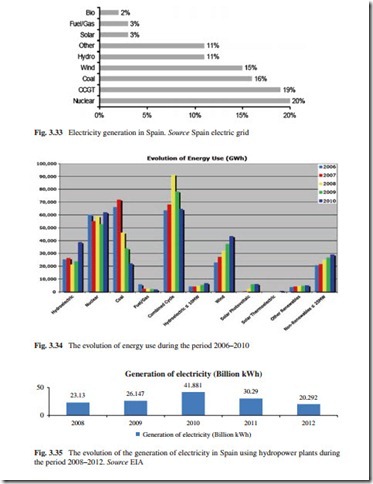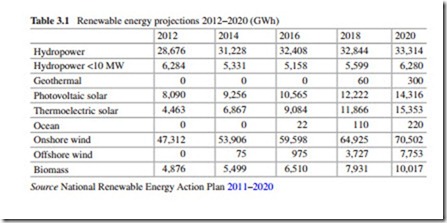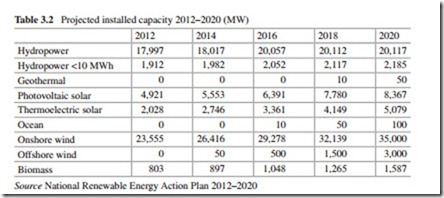Spain
According to the World Energy Council, in terms of hydroelectric resources, Spain stands in the middle rank of West European countries, with a gross theoretical capability of 162 TWh per year. The average level of hydroelectricity generation (excluding pumped-storage plants) in 2011 (approximately 25 TWh) indicates that Spain has already harnessed a considerable proportion of its economic hydro resources. Currently, some 450 MW of small hydropower capacity is scheduled to be added, leading to an eventual total output from small-scale hydropower of around 6,000 GWh per year. Undoubtedly, hydropower was one of the three renewable energies that contributed heavily toward Spain, generating 35 % renewable power in 2010.
Hydropower Installed Capacity
The total hydropower capacity installed in the country in comparison with the total capacity installed reached 12.24 % in 2012. The hydropower capacity installed in 2012 represents 31.27 % of the total renewables capacity installed in the country in that year. It is important to single out that the majority of the hydropower plants are located in the Northern part of the country.
Hydropower has great potential to add to the Spain’s energy sector. In 2010, Spain had 1,047 small hydropower plants and a total installed capacity of 1,926 MW generating 4,719 GWh. In 2010, Spain was able to meet 35 % of its electricity demand using renewable energies. The renewable energy sources with the largest contribution to the generation of electricity were wind, hydropower, and solar energy (Williams 2011). In 2012, the total installed hydroelectric capac- ity was 13,242 MW.
Theoretically, hydropower is capable of providing 138 TWh of power23; this estimation is after water consumption is taken into account (Williams 2011). It is expected that by 2020, the country should have 1,100 hydropower plants with a total installed capacity of 2,185 MW (6,280 GWh) (Liu et al. 2013).
The total investment that the government is expected to implement in the hydropower sector until 2020 has been estimated between US$ 4 and US$ 6 million, according to IEA sources. The operation and maintenance costs have been estimated for the hydropower sector in around € 27 per MWh.
Hydropower Electricity Generation
Electricity generation has been increasing steadily over the past ten years. The total net electricity production in Spain was 280 TWh in 2011, of which 3 TWh was used for pumped hydro. The domestic demand was about 270 TWh. The electricity mix is shown in Fig. 3.33. (Liu et al. 2013).
According to Fig. 3.33, the participation of hydropower plants in the generation of electricity in Spain is 11 %.24 The average small hydropower growth over the past ten years had barely reached 2.1 % annually; this represents a capacity increase of 36 MW per year on average. Growth in the use of hydropower plants for the generation of electricity in Spain was low due to a series of barriers that have virtually paralyzed the sector during the past years. The previous renewable energy plan for the period 2005–2010 set out for small hydropower sector to achieve a total installed capacity of 2,199 MW by 2010, but this goal was not achieved for hydropower plants under 10 MW due to different factors (Liu et al. 2013). During the period 2006–2010, hydropower plants increased its role in Spain’s the energy mix from around 25,000 GWh in 2006 to around 39,500 GWh in 2010 (see Fig. 3.34).
The evolution of the generation of electricity in Spain using hydropower plants during the period 2008–2012 is shown in Fig. 3.35.
According to Fig. 3.35, the generation of electricity using hydropower plants in Spain during the period 2008–2012 decreased 12.3 %. However, during the period 2008–2010, the generation of electricity using this type of energy source increased
81.1 %, while during the period 2010–2012 decreased 51.6 %. It is expected that the use of hydropower plants for the generation of electricity in Spain will increase once again during the coming years, particularly when the economic crisis that the country is facing finish. However, perhaps the objective to be reached by 2020 will not be achieved due to implementation of the following new administrative procedures and concession in the sector:
• Streamlining current procedures for water planning in the river sections where hydropower plants can be implemented under certain conditions, such as residual flows;
• Establish a new unified administrative procedure for water concessions or modification of the existing ones, applicable for hydropower plants up to 50 MW;
• Promotion of tenders in existing public infrastructures, with new rules for the renovation of concessions and the possibility of modification of concessions already granted;
• Establish the possibility to modify existing water concessions for electricity generation by the responsible authority (i.e., to avoid the process of competing for water concession in cases where the modification does not cause an increase or decrease of the maximum flow nor of the capacity installed greater than 50 % of the originally amounts granted and consistent with the River Basin Management Plan in force) (Liu et al. 2013).
According to the government plan, it is seen that wind power is set to remain the largest renewable energy source until 2020. Hydropower and solar power also remain second and third place when it comes to renewables. It is expected that the hydropower output in 2020 reached 21 %; this represents an increase of 9 % with respect to the level reached in 2010.
According to Table 3.1, the hydropower projections for the period 2012–2020 show an increase in the generation of electricity from 28,676 GWh in 2012 up to 33,314 GWh in 2020; this represents an increase of 16.2 %. The use of hydro- power plants for the generation of electricity during the period considered
occupies the second place after onshore wind. The hydropower projected capacity for 2020 will be also second behind the wind projected capacity to be installed in that year (see Table 3.2).
Finally, it is important to highlight that the electricity transmission in Spain has been expanding in the past years. Now, Spain is connected to Portugal, France, Andorra, and Morocco. The largest of these interconnections is between Spain and its neighbor on the peninsula, Portugal.


